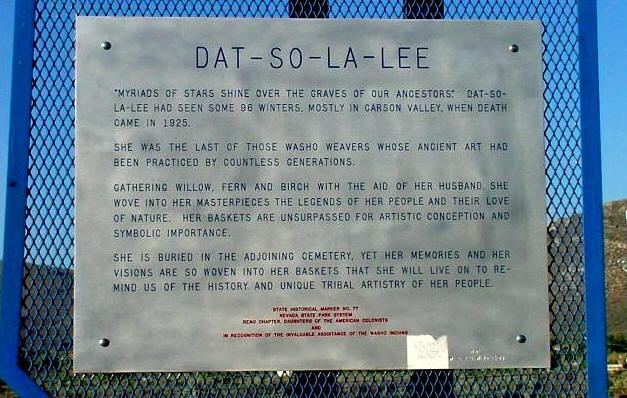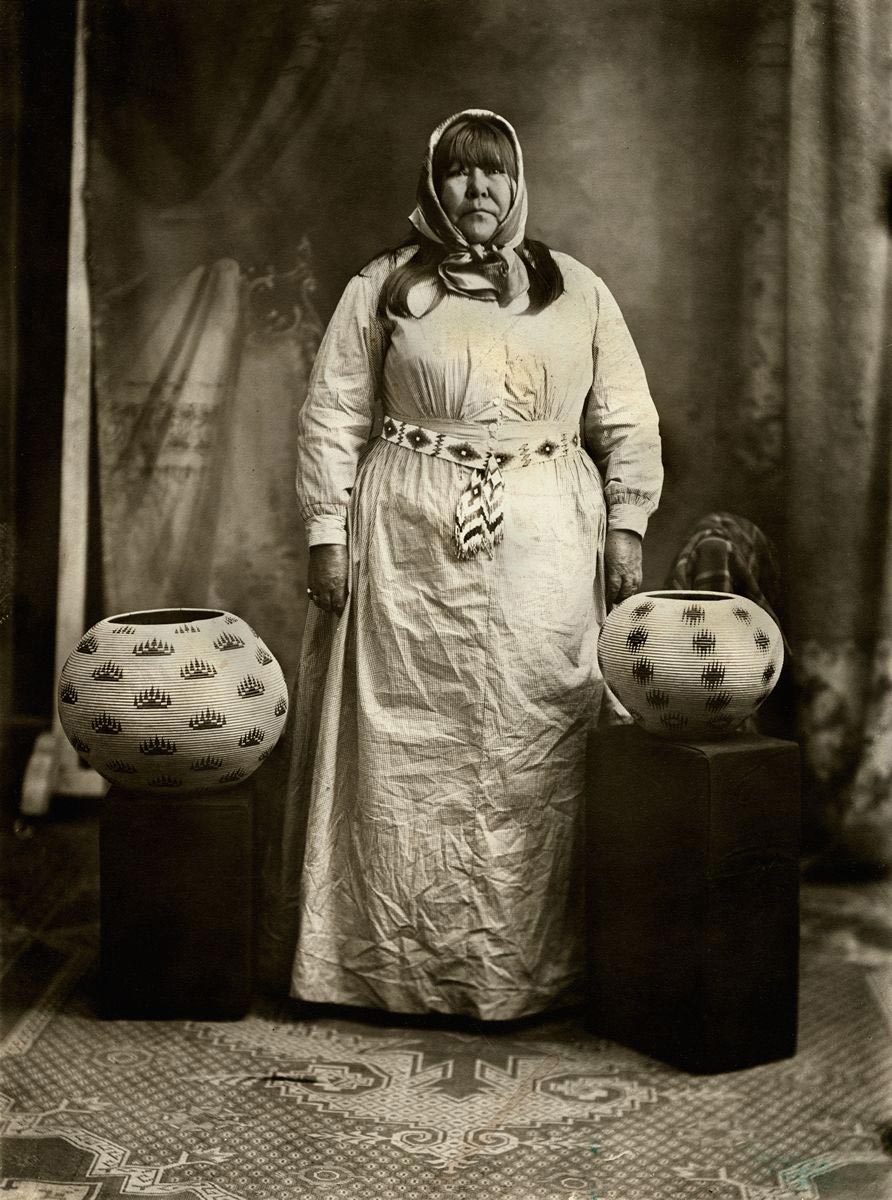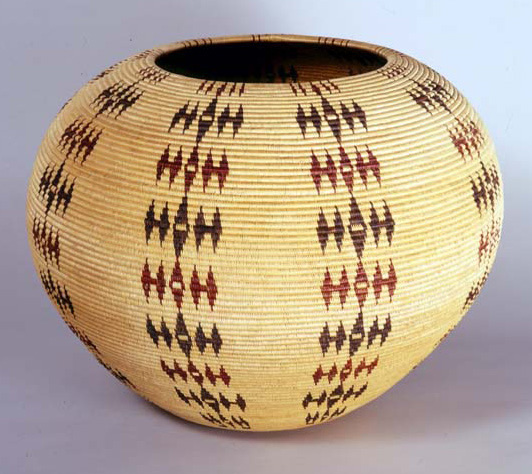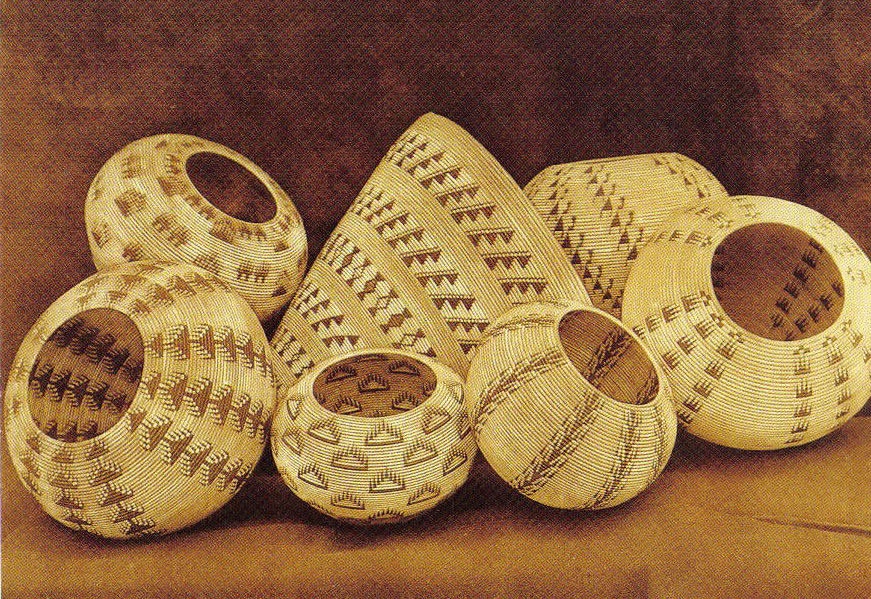

Dat-so-la-lee
  |
| The Carson County, Nevada burial place of Dat-so-la-lee, a Washoe basketmaker of unrivaled genius. |
The plaque pictured above doesn't begin to tell the story of why Dat-so-la-lee was such a powerhouse woman. She undoubtedly saved many friends and family members from starvation, enslavement or banishment. Here, briefly, is her story. She was one of many practitioners of a Native art - the art of basketmaking. In Dat-so-la-lee's homeland the art of basketmaking had been passed down for at least 10,000 years, never skipping a generation. No generation was skipped because baskets were vital to life - perhaps as many as 65% of all objects made and used in the Great Basin were baskets. Baskets were used for gathering, cooking and serving food; for storage; for transport; for gifts; for sale to others; and as symbols of individual and group identity. Her ability to make perfect baskets was a result of all of those 10,000 years of development. Like artistic geniuses the world over, Dat-so-la-lee was able to synthesize the ideas of those who came before her into a revolutionary form that answered a new esthetic and cultural need. Her baskets are exceptional. Everyone who sees them knows that they are in the presence of artistic genius. The proof of her genius is reflected in the sales prices of her baskets. A basket that took her six months to manufacture sold for $30 or $40; at modern art auctions minimum bids on her baskets range between $30,000 and $400,000 and they sell like hotcakes. To produce a genius basket each step of the process must be carefully controlled. The gathering and preparation of basketry materials takes at least as long as the actual stitching of the basket. Materials must be collected at specific times of the year and the plants must be pruned and burned to give the best, unblemished materials. Materials for design elements must be dyed. These steps require fine-tuned and deep knowledge of the life-cycles and habits of basketry plants; that knowledge was passed on and faithfully updated as environmental conditions changed over thousands of years. Dat-so-la-lee's exposure to the designs of other tribes catapulted her into new conceptual territory. Prior to this time, designs and forms were closely associated with particular groups as a kind of identity mechanism. Her goal was sales and with this motivation Dat-so-la-lee crossed culture lines to synthesize the forms, colors, and designs of the artists of other tribes into her own work. The result was that the shapes and proportions of Dat-so-la-lee's baskets please the visual sense. The shapes resonate with us like human forms. The designs are so perfectly radially symmetrical that they embody the human concept of beauty, which is perfect symmetry. They sit lightly on the surface, almost appearing to hover slightly above the surface so that they accentuate the lines and forms. Her sense of design placement is impeccable and her design elements exemplify the use of the disconnected forms that typify Washoe basketmakers' designs but incorporate elements from other tribes to bring a new vitality to form and design. The design fields keep the viewers' eye moving so one never tires of looking at the patterns. Dat-so-la-lee's works are technically perfect masterpieces of rotational geometry. Unlike Rembrandt or DaVinci, Dat-so-la-lee worked out her designs in her head and did not sketch them out on paper. Her designs were calculated in process and were of such a complexity that modern basketmakers can't match her conceptualizations of the finished product, which she held in her head. Every inch of the surface of the basket is covered by more than 35 stitches to the inch. A basket with an 18" diameter requires more than 1,000 stitches to work one row; a large basket may have a stitch count of more than 50,000 stitches. The materials Dat-so-la-lee used were unblemished by dark spots or twisting. The withes (the strands from which baskets are made) are all finished to a uniform dimension 1/36" wide and 1/64" thick before the stitching begins. The willow rods that are covered by the stitching are all finished to a uniform diameter proportional to the size of the finished basket. This assures that the surface of the basket will appear as a uniform skin without discolorations, puckers, or sunken areas. Technical and artistic genius are only two-thirds of the genius of Dat-so-la-lee. The rest of her genius was founded on her love of her people and her compassion for their suffering. While her technical genius was the product of thousands of years of continual improvement by the lineage of artists of which she was a member, her artistic genius was also a product of her internal emotional and cognitive approach to the world. Like a masterwork basket, a genius basketmaker is a coming together of elements in an ideal way. The final element of Dat-so-la-lee's genius was rock-solid business acumen. It was her business acumen as well as her artistic and technical genius that allowed Dot-so-la-lee to fill a remarkable role as the first to develop a recognizable "brand" of basket and to form the first loose cooperative of basketmakers dealing with the White world of collectors. Dat-so-la-lee worked as a laundress for miners and residents of Carson Valley in the last half of the 19th Century. Eventually she began to work as a laundress for the Cohns, an entrepreneurial couple who came to Dat-so-la-lee's homeland and set up a general store near her home. At the store Dat-so-la-lee saw baskets made by artists from other tribes. Soon she brought the Cohns a few of her baskets and very quickly the Cohns employed her as a full-time basketmaker. As her fame grew, her family and friends began to work in the new style that Dat-so-la-lee invented. Art historian, Martin Cohadas makes a strong argument that many of the baskets attributed to Dat-so-la-lee were actually made by her sister-in-law and friends from the Carson Valley. In this way, she loaned her "brand name" to others to help them command higher prices for their work, thus keeping the wolf from many doors. George Wharton James wrote of Dat-so-la-lee in his 1903 publication Indian Basketry (Rio Grande Press). He emphasized that she knew her market, and knew it well. "The 'queen' of the Washoe weavers is Dat-so-la-lee...whose work is wonderful in its shape, symbolization and weave. Though heavy and plump, her delicacy of touch, artistic skill and poetical conception excite admiration. Her hand is symmetrically perfect, her fingers plump and tapering and her nails beautiful 'filberts.' She is fully conscious of the sensations and emotions that her work arouses in the hearts of connoisseurs." |
 |
 |
 |
 |
 |
 |